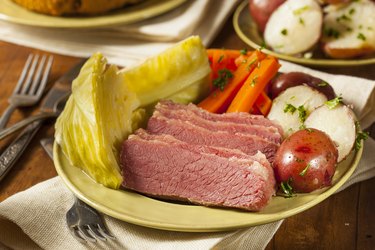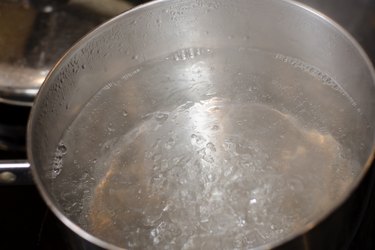There are a lot of fully cooked hams in stores, but it’s tradition to glaze and cook the ham first, which makes it taste even better. Cooking ham in a convection oven means adjusting both temperature and cook time slightly from conventional oven recipes.
There are so many kinds of ham that the USDA Food Safety and Inspection Service (USDA FSIS) wrote an entire article to explain the differences and how to cook each kind. So before you start cooking, make sure you know what kind of ham youre dealing with.
One of the most important questions you may have is: What’s the difference between cured and uncured ham? Curing meat means adding salt, nitrites or nitrates, and other spices to help it stay fresh and develop its color and flavor. Curing spices can be rubbed on the meat or injected into it. Depending on the method used, they can give the meat a rich flavor and a color that ranges from deep pink to mahogany.
Your ham may also be smoked, boiled or, less commonly, completely uncured. This ham is called “fresh” and will be marked as such. It will be pale beige or pink, like a pork roast that hasn’t been cooked yet.
Because different kinds of ham are so different, even the USDA FSIS says to read the label carefully to make sure you know what kind of ham you have and how to cook it right.
A turbo convection oven can take your ham to incredible new heights. With its precise temperature control, turbofan and advanced cooking modes this innovative appliance unlocks juicy flavorful ham perfection. But to harness its potential, you need the right techniques.
In this comprehensive guide, we provide turbo convection oven ham cooking tips from start to finish. Follow our recommendations on choosing a ham, prepping, glazing, monitoring doneness, and more. With a few simple tricks, you’ll be serving up mouthwatering convection oven ham to impress family and friends. Let’s get cooking!
Pick the Right Ham for Roasting
For optimal results, choose a bone-in, uncured fresh ham ranging from 5 to 10 pounds. The bone adds flavor, and uncured ham gives you better control over seasoning Avoid pre-cooked hams, which dry out Have the butcher trim excess skin and fat.
Proper Preparation is Key
Rinse your fresh ham and pat it completely dry. For better browning and glaze absorption, use a sharp knife to make crosshatch marks on the fat cap and meat. Avoid cutting into the meat.
You could soak your scored ham in a simple brine overnight to add saltiness and moisture.
Setting Up Your Turbo Convection Oven
-
Place ham on a rack in a roasting pan for air circulation. Add 1⁄2 cup broth or cider to the pan.
-
Set your oven to Convection Roast or Convection Bake at 300°F. This low temp prevents drying out.
-
If available, use an oven-safe probe thermometer to monitor internal temp.
-
Let the turbo oven fully preheat before adding your ham.
Calculate Cook Times
Cooking times vary based on size. Estimate 12-15 minutes per lb for a bone-in, fresh uncured ham. For example, a 10 lb ham will take 2 to 2 1⁄2 hours.
Rely on a meat thermometer for doneness – target between 145°F-150°F. Let rest at least 15 minutes before carving.
Glazing Guidelines
For added flavor and sheen, glaze during the last 30-45 minutes of roasting:
-
Mix glaze ingredients like brown sugar, honey or fruit preserves. Heat to thicken slightly.
-
Brush glaze on ham every 10-15 minutes to caramelize.
-
Avoid tenting foil over the ham when glazing for best results.
-
Increase oven temp to 400°F once glazed to set the coating.
Step-by-Step Method
Follow these steps for perfectly cooked turbo convection oven ham:
-
Prep 5-10 lb fresh uncured ham and score fat cap. Soak in brine if desired.
-
Place ham on rack in roasting pan. Add 1⁄2 cup broth to pan.
-
Set turbo convection oven to 300°F Convection Roast. Insert oven thermometer.
-
Roast approximately 12-15 minutes per lb until thermometer reaches 145°-150°F internally.
-
During last 30-45 minutes of cooking, glaze ham every 10-15 minutes.
-
Once glazing starts, increase oven temp to 400°F to caramelize glaze.
-
When ham reaches target temp, remove from oven and tent foil. Let rest 15 minutes before slicing.
Handy Ham Roasting Tips
-
For more smoke flavor, add soaked wood chips to pan.
-
Mix up glazes with spices, fruits, jams, juices or specialty mustards.
-
Use broth, cider or wine for pan liquid instead of water.
-
Tent foil if ham browns too quickly or unevenly.
-
Carve across the grain for tender slices.
-
Allow oven to fully preheat before adding ham.
With the right preparation and cooking techniques, your turbo convection oven will reward you with the juiciest, most flavorful ham possible. Experiment with different glazes and seasonings to put your own signature touch on this classic dish. Happy roasting!
Frequently Asked Questions
What’s the difference between a conventional oven and a turbo convection oven?
Turbo convection ovens cook faster and more evenly due to a fan that circulates hot air. They require lowering temperature by 25°F versus conventional.
Should I buy a cooked ham or fresh uncured ham?
For the best results, choose an uncured fresh ham. Cooked or cured hams may dry out. Have the butcher trim it.
Where should I insert the meat thermometer?
Insert the thermometer into the thickest part of the ham, taking care to avoid touching any bones. This ensures an accurate reading.
How can I add more flavor to my ham?
Include aromatics in the pan liquid like garlic, onions, or herbs. Or glaze frequently with boldly flavored sauces. Injecting brines also adds flavor.
Can I use a cooking bag or foil when roasting ham?
Cooking bags or heavy foil covering are not needed with convection cooking, as the turbofan circulates air well. Tent lightly with foil if needed.
How should I reheat leftover ham?
Place ham slices on a baking sheet in a 300°F oven for 10-15 minutes until warmed through. Or microwave individual slices for 30 seconds.

Prep Your Ham and Glaze
In most cases, youll be dealing with a fully cooked ham. Prepare it by trimming away excess fat and scoring it all over with a sharp knife. Make these shallow cuts in opposing directions to create a square or diamond pattern for better coverage.



Place the ham on a rack in a broiling pan. If the ham is whole, put it on its side; if it’s cut, put it cut-side down. Wet the bottom of the pan with water to help the ham stay moist. Adding herbs to the water will also make the ham taste better. If you dont have a cover for the broiling pan, create a foil tent over the ham.
Next, combine sweet and tangy ingredients to create a glaze. Adding brown sugar, Dijon mustard, and apple cider vinegar to taste and stirring them together will make a simple but tasty glaze. Simmer the glaze until it’s about half gone. Other common glaze ingredients include honey, rice vinegar, pepper, Worcestershire sauce and assorted spices.
As youre prepping the ham, set the oven to preheat. Most of the cooking temperatures published for ham are calculated for a conventional oven. Most experts say that if you use a convection oven instead of a regular oven, you should set it 25 degrees Fahrenheit lower.
If your ham doesnt have specific temperature directions on it, the USDA FSIS recommends setting a conventional oven no lower than 325 F to reheat a pre-cooked ham — which translates to 300 F for a convection oven.
Once the oven is preheated, slide the pan into its center. Different experts have different ideas about how often you should glaze your ham. Some say to do it every 10 to 20 minutes and baste it with pan juices while you’re at it, while others say that just one glaze, about 20 minutes before the ham is done, is enough.
To get a delicious, caramelized crust on your glazed ham, glaze it many times. Then, near the end of the cooking time, take off the foil tent or lid and set the oven to broil for a few minutes. Watch carefully to make sure the ham doesnt burn.
The University of Kentucky says that convection ovens cook food up to 25 percent faster than regular ovens. But converting convection oven vs. regular cooking times isnt an exact science. If you use a meat thermometer to check when your ham is done, you can be sure of good results and safe food.
According to FoodSafety.gov, a cooked ham (which is what youll most commonly find in stores) should be reheated to an internal temperature of 165 F — although they allow an exception of 140 F for cooked hams that were packaged in a USDA-inspected plant. If youre working with a fresh ham, it should be heated to an internal temperature of 145 F, then allowed to rest for three minutes.
If you have an oven-safe leave-in thermometer, you can check the temperature inside the ham without even opening the oven door.
The USDA FSIS recommends placing your meat thermometer midway into the cut of meat; if the bone is still in your ham, place the thermometer to avoid it. And if your ham is an irregular shape, check its temperature in several places to be sure its cooked all the way through.
